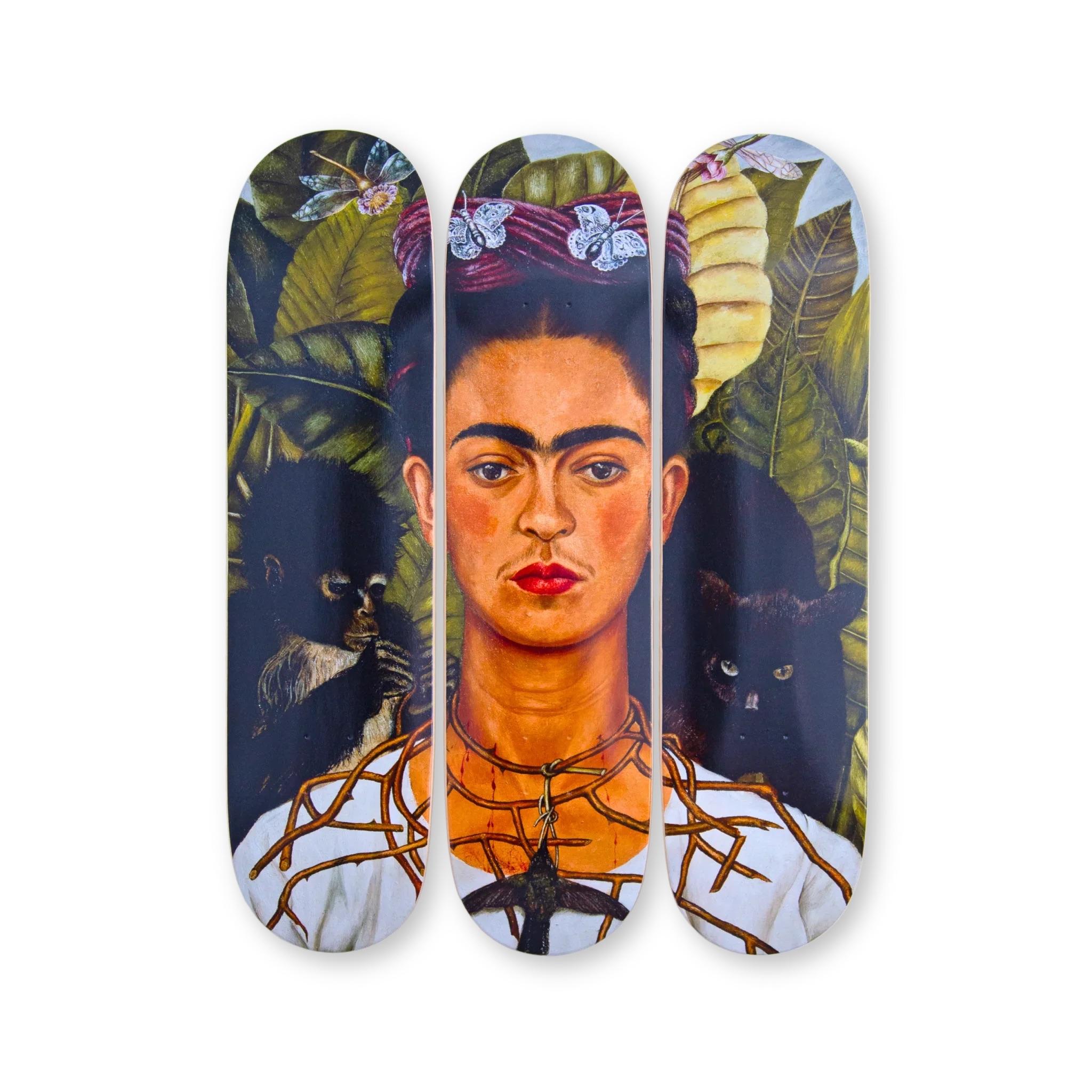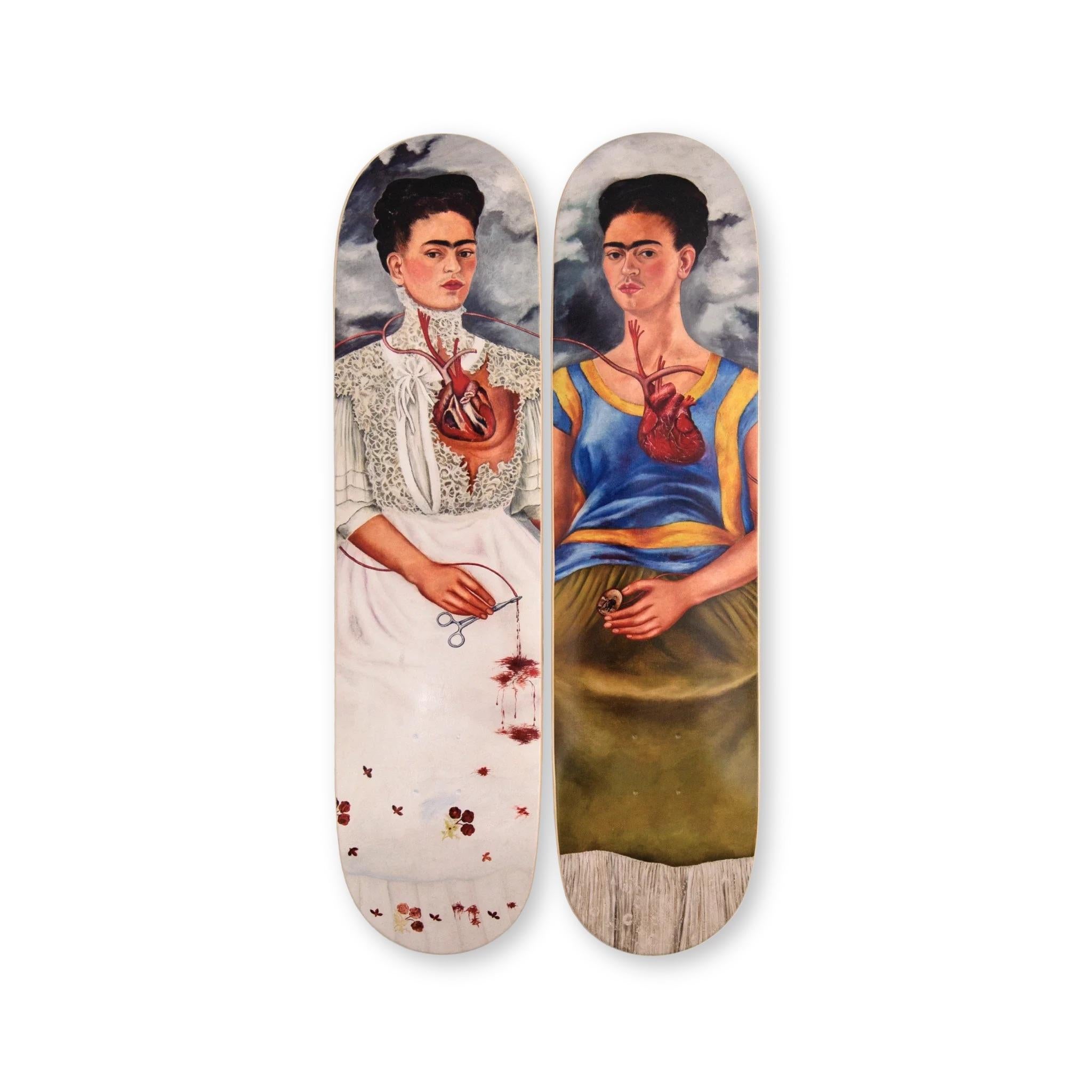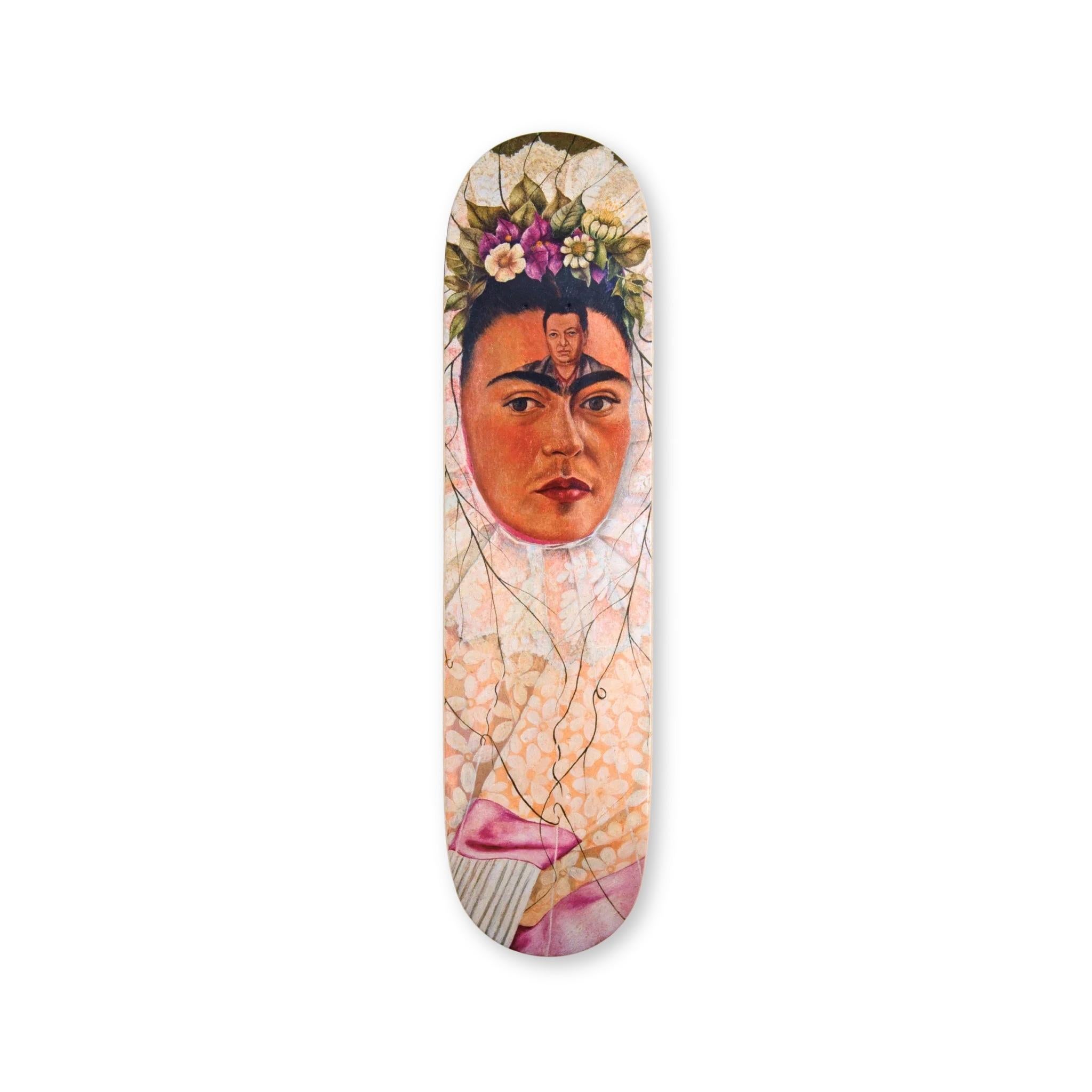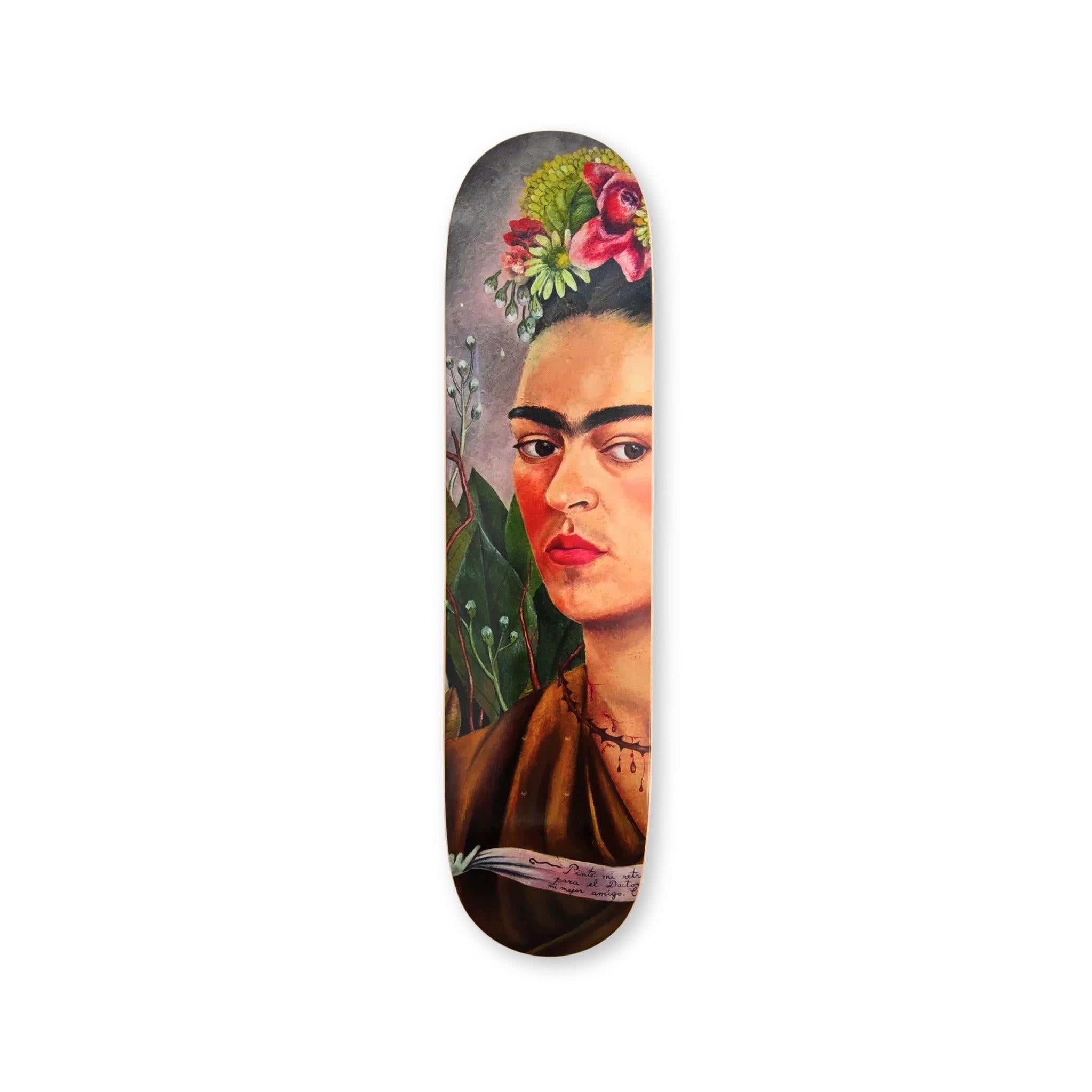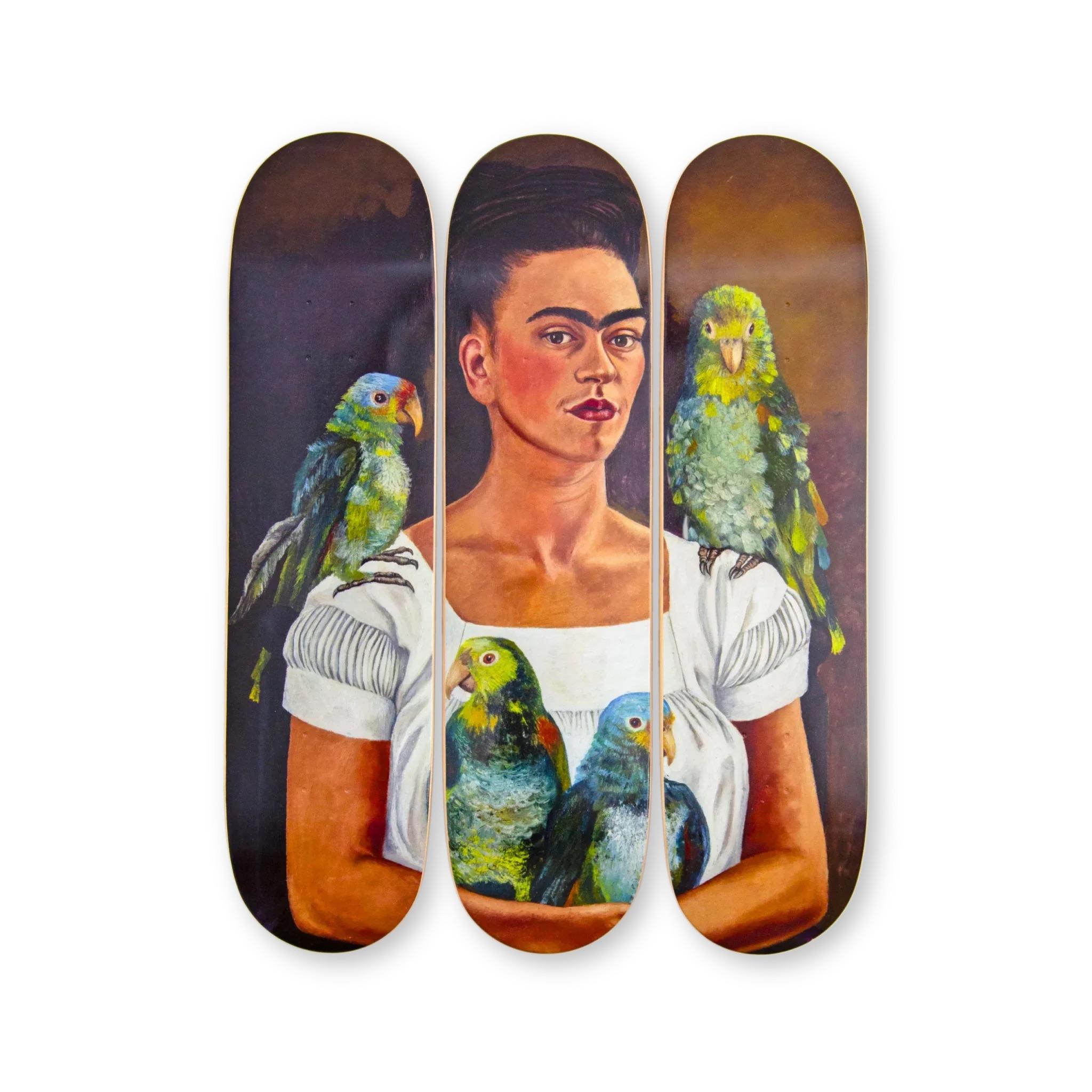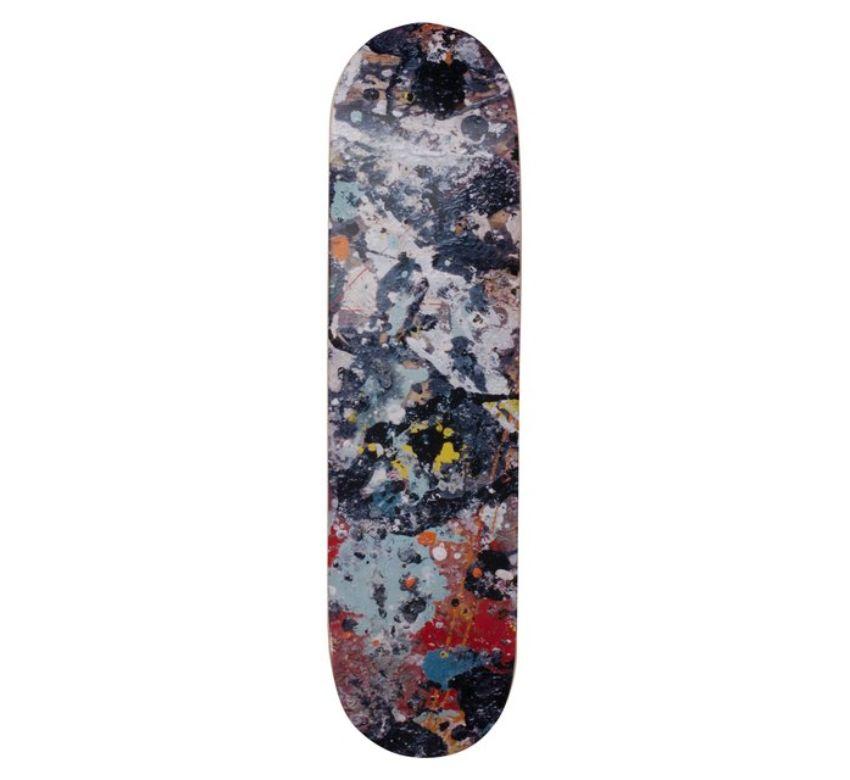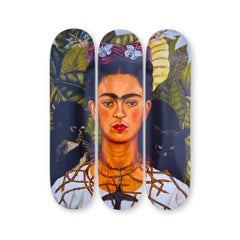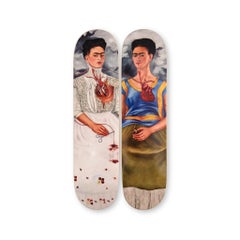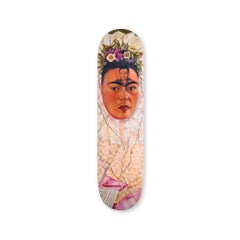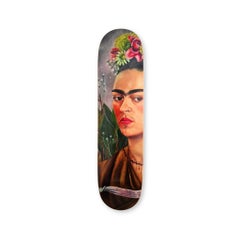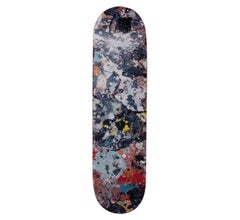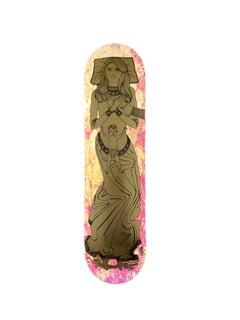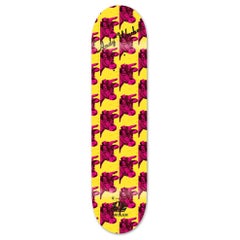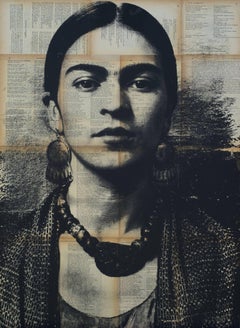Items Similar to FRIDA KAHLO - The Wounded Deer. Skate Deck Modern Design Pop
Want more images or videos?
Request additional images or videos from the seller
1 of 3
FRIDA KAHLO - The Wounded Deer. Skate Deck Modern Design Pop2025
2025
$409.42
£305.70
€345
CA$575.23
A$629.38
CHF 324.76
MX$7,536.74
NOK 4,122.95
SEK 3,862.81
DKK 2,627.96
About the Item
Frida Kahlo - The Wounded Deer
Date of creation: 2025
Medium: Digital print on Canadian maple wood
Edition: Open
Size: 80 x 20 cm
Condition: In mint conditions and never displayed
Skate deck made of 7 ply grade A Canadian maple wood.
©2025 Banco de México Diego Rivera Frida Kahlo Museums Trust, Mexico, D.F. / Artists Rights Society (ARS), New York
The Wounded Deer (1946) is like a visual poem that Frida Kahlo wrote with arrows and melancholy, but never losing her sharp sense of humor. In this work, Frida transforms into a wounded deer—literally—with nine arrows piercing her body, an image that blends physical and emotional pain with an almost theatrical elegance.
The deer, half human and half animal, moves through a mysterious and silent forest, as if trapped in a dream where suffering becomes metaphor. Her large dark eyes look at us with a mix of vulnerability and defiance, reminding us that pain is not only endured but carried with dignity and a touch of rebellion.
Here, Frida not only exposes her wounds—often the result of her accident and turbulent life—but also plays with the idea of fragmented identity and resilience. In that body pierced by arrows, seemingly on the verge of giving way, beats an indomitable and bold spirit.
The Wounded Deer is a modern fable where suffering takes center stage but also becomes an act of aesthetic courage. It reminds us that fragility can be powerful, and that sometimes art becomes the best refuge to heal what cannot be cured.
ABOUT THE ARTIST
Frida Kahlo was born in the Blue House of Coyoacán, Mexico, in 1907—although she later claimed to have been born in 1910, aligning her birth with the start of the Mexican Revolution. It wasn’t vanity; it was a statement. Frida didn’t just live through time—she reimagined it with every brushstroke.
As a child, she contracted polio, leaving one of her legs thinner than the other. To compensate, she developed an even larger personality. But it was in 1925, when a streetcar accident shattered her spine, pelvis, and much of her body, that her life split in two—literally and symbolically. Most would have been defeated. Frida turned pain into language.
During her recovery, she began to paint. A mirror placed above her bed allowed her to transform her face into fertile ground for symbolism, memory, and resistance. She didn’t paint what she saw—she painted what she felt, remembered, endured. Her self-portraits were not simply likenesses but visual manifestos: her face framed by monkeys, thorns, flowers, roots, corsets, and, always, that singular unibrow—one bold line of unbroken thought.
In 1929, she married the muralist Diego Rivera, launching one of the most tempestuous love stories in art history. Their relationship was marked by infidelities, separations, and reconciliations—fuel for both drama and creativity. “I had two accidents in my life,” she once quipped, “one was the streetcar, the other was Diego. Diego was the worst.” And still, she loved him. In her own way.
Frida was political, communist, a voracious reader, a collector of traditional dress, a lover of men and women, a bold hostess, and a tireless provocateur. Her unique style—embroidered huipils, long skirts, floral crowns, and Indigenous jewelry—was not just fashion, but a cultural and personal declaration. Aesthetic and ideology intertwined.
Though she exhibited in Paris and New York and earned the admiration of figures like Picasso and Breton, during her lifetime she was often seen as “Diego Rivera’s eccentric wife” more than as an artist in her own right. It wasn’t until decades after her death in 1954 that her legacy truly exploded: feminist, queer, Latin American, unrepentantly original.
Today, Frida Kahlo is far more than an artist—she is a symbol of resistance, radical authenticity, and fierce beauty. Her legacy transcends museums and textbooks to live on in popular culture, street art, tattoos, fashion, and, above all, in the hearts of those who see in her the proof that art doesn’t need permission to be truth.
Frida never sought immortality. And yet, she found it.
- Creation Year:2025
- Dimensions:Height: 31.5 in (80 cm)Width: 7.88 in (20 cm)Depth: 0.79 in (2 cm)
- Medium:
- Movement & Style:
- After:Frida Kahlo (1907 - 1954)
- Period:
- Condition:
- Gallery Location:Madrid, ES
- Reference Number:1stDibs: LU1033116619632
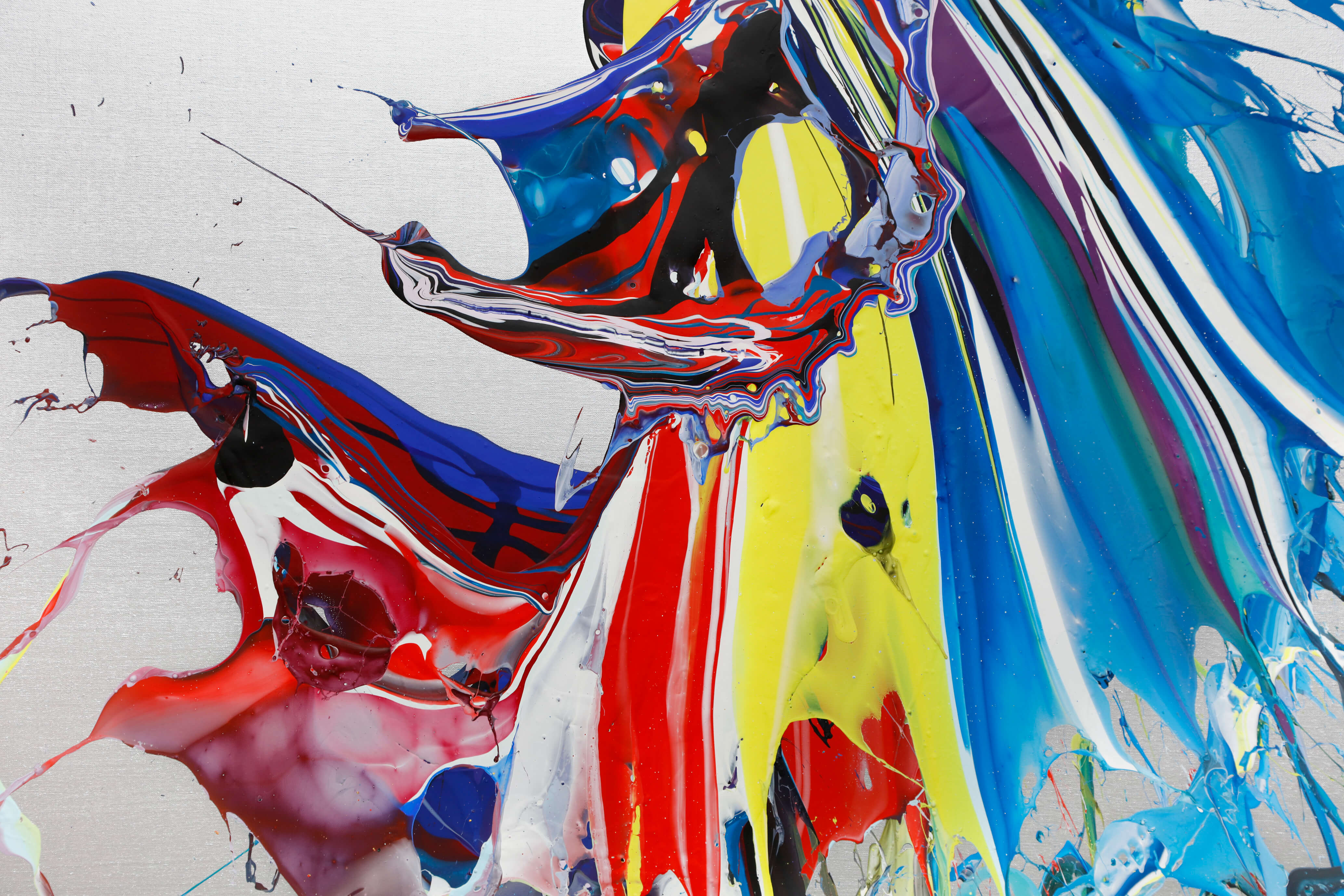
About the Seller
5.0
Gold Seller
Premium sellers maintaining a 4.3+ rating and 24-hour response times
Established in 2011
1stDibs seller since 2018
181 sales on 1stDibs
Typical response time: 14 hours
- ShippingRetrieving quote...Shipping from: Madrid, Spain
- Return Policy
Authenticity Guarantee
In the unlikely event there’s an issue with an item’s authenticity, contact us within 1 year for a full refund. DetailsMoney-Back Guarantee
If your item is not as described, is damaged in transit, or does not arrive, contact us within 7 days for a full refund. Details24-Hour Cancellation
You have a 24-hour grace period in which to reconsider your purchase, with no questions asked.Vetted Professional Sellers
Our world-class sellers must adhere to strict standards for service and quality, maintaining the integrity of our listings.Price-Match Guarantee
If you find that a seller listed the same item for a lower price elsewhere, we’ll match it.Trusted Global Delivery
Our best-in-class carrier network provides specialized shipping options worldwide, including custom delivery.More From This Seller
View AllFRIDA KAHLO Self-Portrait with Thorn Necklace... Skate Deck Modern Design Pop
Located in Madrid, Madrid
Frida Kahlo - Self-Portrait with Thorn Necklace and Hummingbird
Date of creation: 2025
Medium: Digital print on Canadian maple wood
Edition: Open
Size: 80 x 20 cm (each skate)
Condi...
Category
2010s Expressionist More Art
Materials
Wood, Maple, Screen
FRIDA KAHLO - The Two Fridas. Skate Deck Modern Design Pop
Located in Madrid, Madrid
Frida Kahlo - The Two Fridas
Date of creation: 2025
Medium: Digital print on Canadian maple wood
Edition: Open
Size: 80 x 20 cm (each skate)
Condition: In mint conditions and never displayed
This diptych is formed by two skate decks made of 7 ply grade A Canadian maple wood.
©2025 Banco de México Diego Rivera Frida Kahlo Museums Trust, Mexico, D.F. / Artists Rights Society (ARS), New York
“The Two Fridas” (1939) is like a double portrait with emotional surgery: two Fridas, one with a broken heart and the other with a whole one, sitting side by side as if they had booked a couples therapy session… with themselves.
Each dressed to reflect a part of her identity—the European Frida in a Victorian lace dress...
Category
2010s Expressionist More Art
Materials
Wood, Maple, Screen
FRIDA KAHLO - Self-Portrait as a Tehuana Skate Deck Modern Design Pop
Located in Madrid, Madrid
Frida Kahlo - Self-Portrait as a Tehuana
Date of creation: 2025
Medium: Digital print on Canadian maple wood
Edition: Open
Size: 80 x 20 cm
Condition: In mint conditions and never d...
Category
2010s Expressionist More Art
Materials
Wood, Maple, Screen
FRIDA KAHLO Self Portrait, Dedicated to Dr Eloesser Skate Deck Modern Design Pop
Located in Madrid, Madrid
Frida Kahlo - Self Portrait, Dedicated to Dr Eloesser
Date of creation: 2025
Medium: Digital print on Canadian maple wood
Edition: Open
Size: 80 x 20 cm
Condition: In mint condition...
Category
2010s Expressionist More Art
Materials
Wood, Maple, Screen
FRIDA KAHLO - Me And My Parrots. Skate Deck Modern Design Pop American
Located in Madrid, Madrid
Frida Kahlo - Me And My Parrots
Date of creation: 2025
Medium: Digital print on Canadian maple wood
Edition: Open
Size: 80 x 20 cm (each skate)
Condition: In mint conditions and neve...
Category
2010s Expressionist More Art
Materials
Wood, Maple, Screen
JEAN-MICHEL BASQUIAT - Both Poles. Skate Decks Pop Urban Art Design
By Jean-Michel Basquiat
Located in Madrid, Madrid
Jean-Michel Basquiat - Both Poles
Date of creation: 2024
Medium: Digital print on Canadian maple wood
Edition: Open
Size: 80 x 20 cm (each skate)
Condition: In mint conditions and never displayed
This triptych is formed by three skate decks made of 7 ply grade A Canadian maple wood.
© Estate of Jean-Michel Basquiat. Licensed by Artestar, New York
This skateboard set reproduces Both Poles (1982), an iconic work by Jean-Michel Basquiat that encapsulates the tensions running through his visual language: past and present, earth and sky, history and immediacy. The original piece, executed in acrylic, oil stick, and collage, presents a fragmented scene dominated by a symbolic mountain, a crescent moon, and charged elements such as a sickle and a post.
Here, Basquiat confronts “both poles” of his inner and outer worlds: excavation and invocation, memory and transmission. This edition brings that conceptual force into the urban language of skateboarding, becoming both a collectible object and a contemporary artistic statement.
Transposed onto the skateboard format, the work becomes a visual declaration that bridges art and street culture, while preserving the expressive and conceptual intensity of the original.
ABOUT THE ARTIST
Jean-Michel Basquiat (1960-1988) was one of the most influential artists of the 20th century, famous for his ability to fuse urban culture, social criticism and art history into a unique style. Born in Brooklyn, New York, to a Haitian father and Puerto Rican mother, his life and work were shaped by his multicultural heritage, the New York art scene and the social tensions of his time. Although his career was brief, his impact on contemporary art has been lasting and significant.
Basquiat showed an interest in art from an early age. His mother, Matilde Andrades, took him to museums and encouraged him to draw. At the age of seven, a car accident left him hospitalized for a time, and it was then that his mother gave him a copy of the anatomy book Gray's Anatomy, which influenced his fascination with the human body and its visual representation.
Despite his early talent, Basquiat's family life was turbulent. His mother was hospitalized for psychiatric problems and his relationship with his father, Gerard Basquiat, was troubled. This instability contributed to Basquiat dropping out of school at age 17 to pursue his artistic career on the streets of New York.
As a teenager, Basquiat joined the New York graffiti scene under the pseudonym SAMO (an acronym for "Same Old Shit"), which he used to sign his cryptic and poetic messages on the streets of Manhattan with his friend Al Diaz. SAMO's graffiti were a mixture of philosophical and social commentary on popular culture, capitalism and religion, and soon attracted the attention of the underground art scene.
In 1980, SAMO "died" when Basquiat and Diaz decided to end their collaboration, marking the beginning of Basquiat's transition from street graffiti to art galleries.
Basquiat emerged as a talent to watch in 1980, when he participated in the group exhibition The Times Square Show, which included other emerging artists from New York's Lower East Side scene. That same year, he attracted the attention of critics and collectors who saw in his work an electrifying blend of street art and neo-expressionism, the predominant movement of the time.
In 1981, art critic René Ricard published the influential essay The Radiant Child in Artforum magazine, which positioned Basquiat as one of the most promising artists of his generation. Shortly thereafter, he met renowned artist Andy Warhol, with whom he formed a close friendship and significant artistic collaboration. This association was instrumental in catapulting his career into the world of high art.
The collaboration with Warhol was a pivotal point in Basquiat's career. The two artists, although coming from very different worlds, shared a fascination with fame and popular culture. Together, they produced a series of works that combined Warhol's pop art icons with Basquiat's raw, spontaneous style.
However, this collaboration was also a source of controversy. Many critics accused Warhol of "exploiting" Basquiat, while others saw the collaboration as a creative dialogue between two genius minds. Although the criticism was mixed, there is no doubt that the relationship between the two artists helped cement Basquiat's reputation in the art world.
Basquiat's style is a unique amalgam of influences. His work is characterized by the use of dismembered human figures, skeletons and internal organs, evoking the fragility of the body and mortality. Basquiat also used symbols that alluded to African-American and African history, such as crowns, masks and references to historical figures such as Toussaint Louverture.
The use of text is another crucial aspect of his work. Words, phrases and numbers appeared in his paintings, often crossed out or overlapped, creating a sense of controlled chaos. These fragmented words provoked a non-linear reading of his works and conveyed multiple layers of meaning.
His art also reflected his concerns about racial issues, especially the place of people of African descent in Western art history and in society at large. The crowns that Basquiat often drew on his figures were a symbol of power and resistance, a way of proclaiming himself "king" in a world that had historically excluded black artists from the upper echelons of art.
In works such as The Death of Michael...
Category
2010s Pop Art More Art
Materials
Wood, Digital
You May Also Like
Skateboard deck
By Jackson Pollock
Located in Washington , DC, DC
Category
21st Century and Contemporary Contemporary Prints and Multiples
Materials
Screen, Board
$760 Sale Price
20% Off
Kate board - skateboard - Grayson Perry
By Grayson Perry
Located in London, GB
Grayson Perry
Kate Board, 2017
Screenprint on skateboard
Made of 7-ply Grade A Canadian Maple wood
31 1/2 × 7 9/10 in 80 × 20 cm
Edition of 999
co-published by the artist and The Sk...
Category
2010s Contemporary More Art
Materials
Wood, Screen
Andy Warhol Cow Skate Deck 2010
By (after) Andy Warhol
Located in NEW YORK, NY
Vintage Andy Warhol Cow Skateboard Deck:
This work originated circa 2010 as a result of the collaboration between Alien Workshop and the Andy Warhol Foundation. A brilliant piece of...
Category
1960s Pop Art More Art
Materials
Offset, Wood
Frida Kahlo, Mixed Media on Wood Panel
Located in Yardley, PA
Frida Kahlo Art on Plywood. Acrylic and vintage book pages adhered on plywood. Ready to hang. The dimensions are 32x24 inches and 1/2 inch thick. Signa...
Category
2010s Pop Art Mixed Media
Materials
Mixed Media
Jeff Koons - Seated Ballerina Skateboard
By Jeff Koons
Located in London, GB
Jeff Koons
Seated Ballerina Skateboard, 2025
High-end digital print on Canadian maple, silver foil pattern.
Includes Certificate of Authenticity
Sk8ology Invisible Floating Skateboa...
Category
2010s Pop Art More Art
Materials
Wood, Digital
Yoshitomo Nara - Light Haze Days Skateboard Deck (Set of 3)
By Yoshitomo Nara
Located in Central, HK
Yoshitomo Nara
Light Haze Days Skateboard Deck Set, 2020
Silkscreen heat transfer on 100% FSC Canadian Maple Wood, produced in Europe
31 × 24 in 78.7 × 61 cm
Category
2010s Mixed Media
Materials
Wood, Maple
